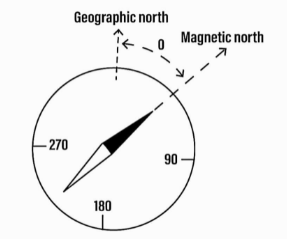
What is a declination? Draw a diagram to show the angle between the declination and true direction of geographic north.
Answer
410.4k+ views
Hint: The angle between magnetic north and true north is described using both declination and variation. From time to time, the term deviation is also employed. This is the term that individuals who study the magnetic field prefer; it is also the one that land navigators use the most. The term "magnetic declination" is sometimes used.
Complete answer:
The angle of the horizontal plane between magnetic north and geographic north is known as magnetic declination. This angle is represented in the figure by a symbol. The angle of declination varies from place to location on the earth's surface, and it also changes with time. The declination is positive if the magnetic north is east of true north, as shown in the diagram, and negative if the magnetic north is west of true north, as shown in the diagram.

Additional Information:
-The declination is greater in higher latitudes than in equators because, the lines of the field close to the magnetic poles come out abruptly by the side of the Earth's axis, by protocol at the South magnetic pole, at a comparatively vertical angle to the polar edges, and curve round to enter again at the north magnetic pole.
-Halfway lines develop between the Earth's surface and the edge of the Earth at a lesser vertical angle after the Earth's surface has previously shifted the direction away from the axis.
Note:The declination angle can be calculated using the following equation
Complete answer:
The angle of the horizontal plane between magnetic north and geographic north is known as magnetic declination. This angle is represented in the figure by a symbol. The angle of declination varies from place to location on the earth's surface, and it also changes with time. The declination is positive if the magnetic north is east of true north, as shown in the diagram, and negative if the magnetic north is west of true north, as shown in the diagram.

Additional Information:
-The declination is greater in higher latitudes than in equators because, the lines of the field close to the magnetic poles come out abruptly by the side of the Earth's axis, by protocol at the South magnetic pole, at a comparatively vertical angle to the polar edges, and curve round to enter again at the north magnetic pole.
-Halfway lines develop between the Earth's surface and the edge of the Earth at a lesser vertical angle after the Earth's surface has previously shifted the direction away from the axis.
Note:The declination angle can be calculated using the following equation
Recently Updated Pages
Master Class 12 Business Studies: Engaging Questions & Answers for Success

Master Class 12 English: Engaging Questions & Answers for Success

Master Class 12 Social Science: Engaging Questions & Answers for Success

Master Class 12 Chemistry: Engaging Questions & Answers for Success

Class 12 Question and Answer - Your Ultimate Solutions Guide

Master Class 12 Economics: Engaging Questions & Answers for Success

Trending doubts
Give 10 examples of unisexual and bisexual flowers

Draw a labelled sketch of the human eye class 12 physics CBSE

Differentiate between homogeneous and heterogeneous class 12 chemistry CBSE

Differentiate between insitu conservation and exsitu class 12 biology CBSE

What are the major means of transport Explain each class 12 social science CBSE

Franz thinks Will they make them sing in German even class 12 english CBSE




